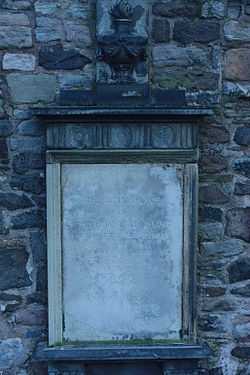William Craig, Lord Craig

William Craig, Lord Craig (1745–1813) was a Scottish judge.
Life
He was the son of William Craig, minister, of Glasgow, and a cousin of Agnes Maclehose. He studied at the University of Edinburgh, and was admitted advocate at the Scottish bar in 1768. In 1784 he discharged the duties of advocate-depute along with Robert Blair and Alexander Abercromby; and in 1787 he became sheriff-depute of Ayrshire.[1]
In 1792, on the death of Lord Hailes, Craig was raised to the bench with the title of Lord Craig, though he had not held a prominent position at the bar. In 1795 he succeeded Lord Henderland as a judge of the court of justiciary, a post which he held till 1812. He retained his office in the civil court till his death 8 July 1813.[1]
He is buried against the eastmost boundary wall of Canongate Kirkyard on the Royal Mile in Edinburgh.
Craig's cousin, Robert Burns' muse, Agnes Maclehose, commonly known as "Clarinda" is buried next to him.
Works
Craig was one of a group of advocates in literary society called the "Tabernacle", who met in a tavern to read essays. On the suggestion of Craig they started a periodical, The Mirror, and they changed into the "Mirror Club". William Creech published The Mirror, on Tuesdays and Saturdays, the first number appearing on Saturday 23 January 1779, and the 110th and last on 27 May 1780. After Henry Mackenzie the contributions of Craig were the most numerous, including a paper on the poems of Michael Bruce, in No. 36. Craig was also a contributor to the Lounger (1785–7), published by the same club.[1]
Notes
- ↑ 1.0 1.1 1.2
 Stephen, Leslie, ed. (1887). "Craig, William (1745–1813)". Dictionary of National Biography 12. London: Smith, Elder & Co.
Stephen, Leslie, ed. (1887). "Craig, William (1745–1813)". Dictionary of National Biography 12. London: Smith, Elder & Co.
- Attribution
![]() This article incorporates text from a publication now in the public domain: Stephen, Leslie, ed. (1887). "Craig, William (1745–1813)". Dictionary of National Biography 12. London: Smith, Elder & Co.
This article incorporates text from a publication now in the public domain: Stephen, Leslie, ed. (1887). "Craig, William (1745–1813)". Dictionary of National Biography 12. London: Smith, Elder & Co.